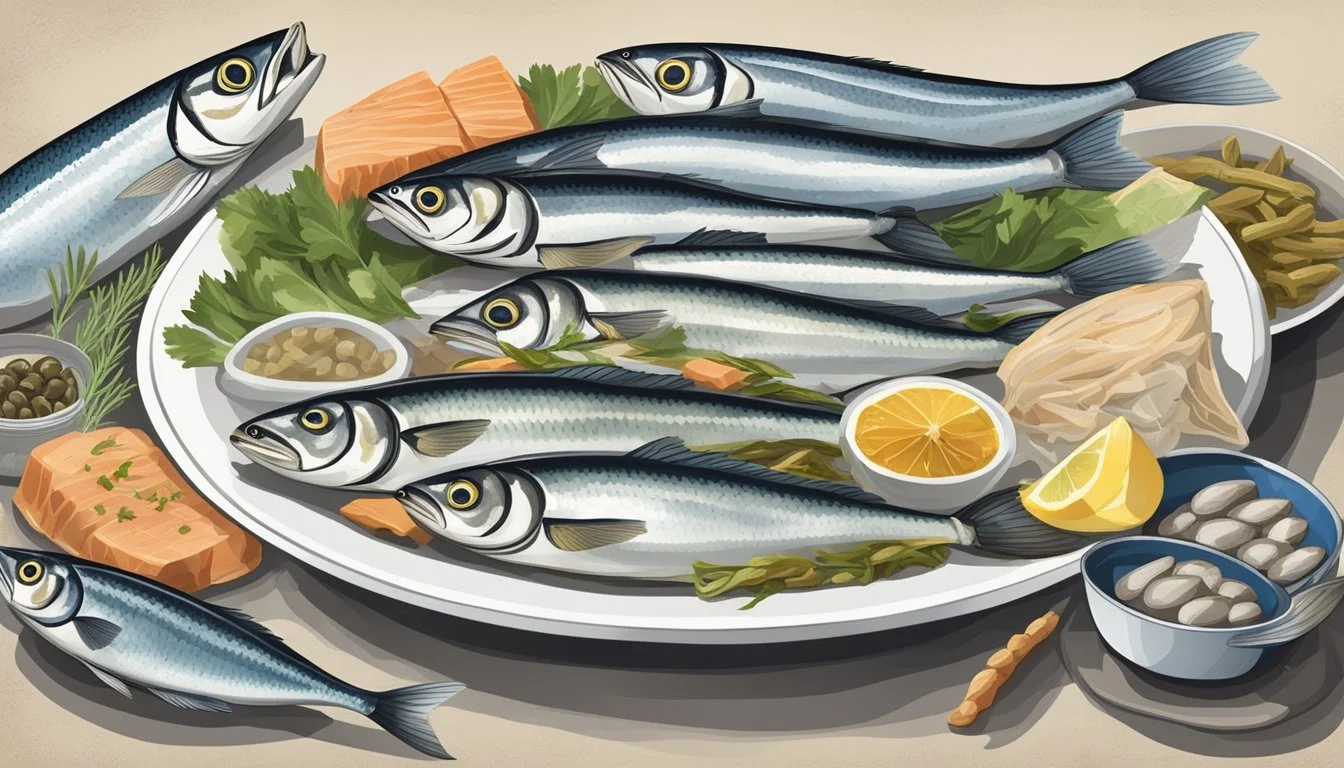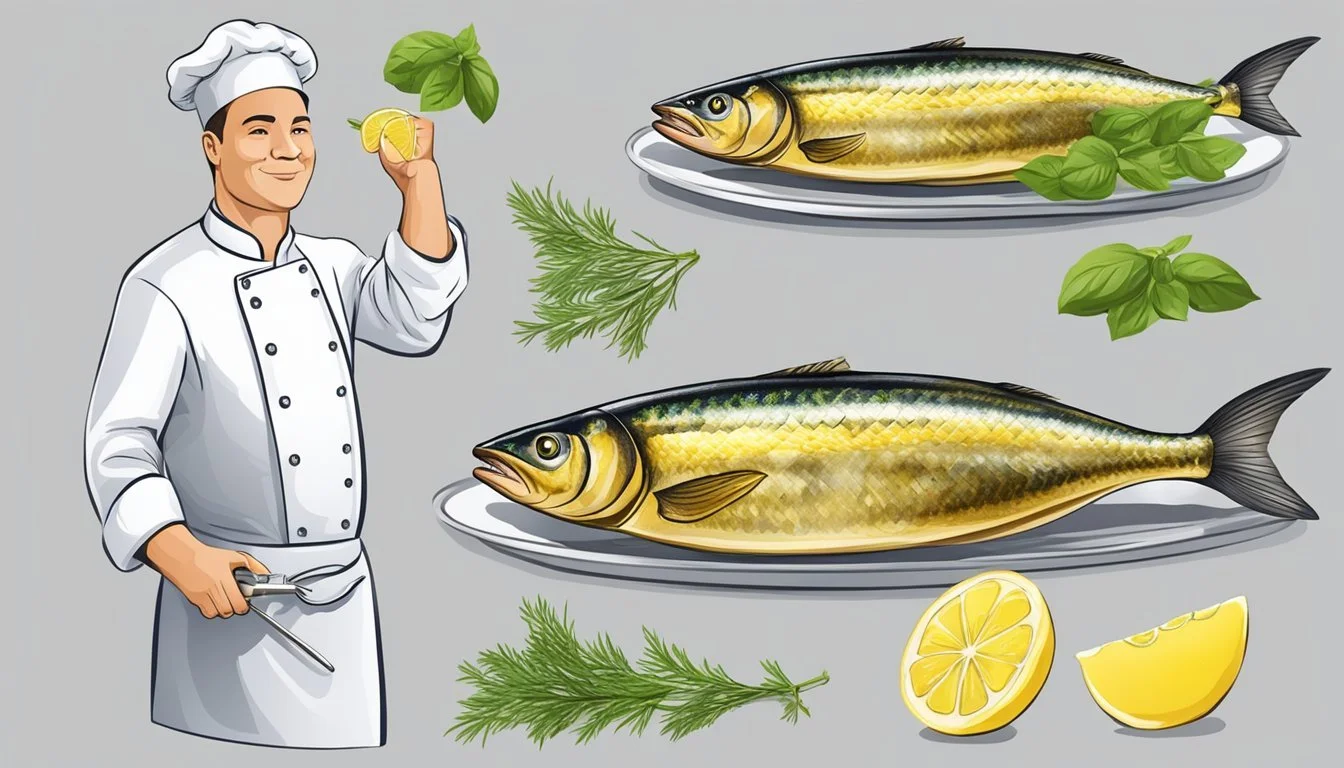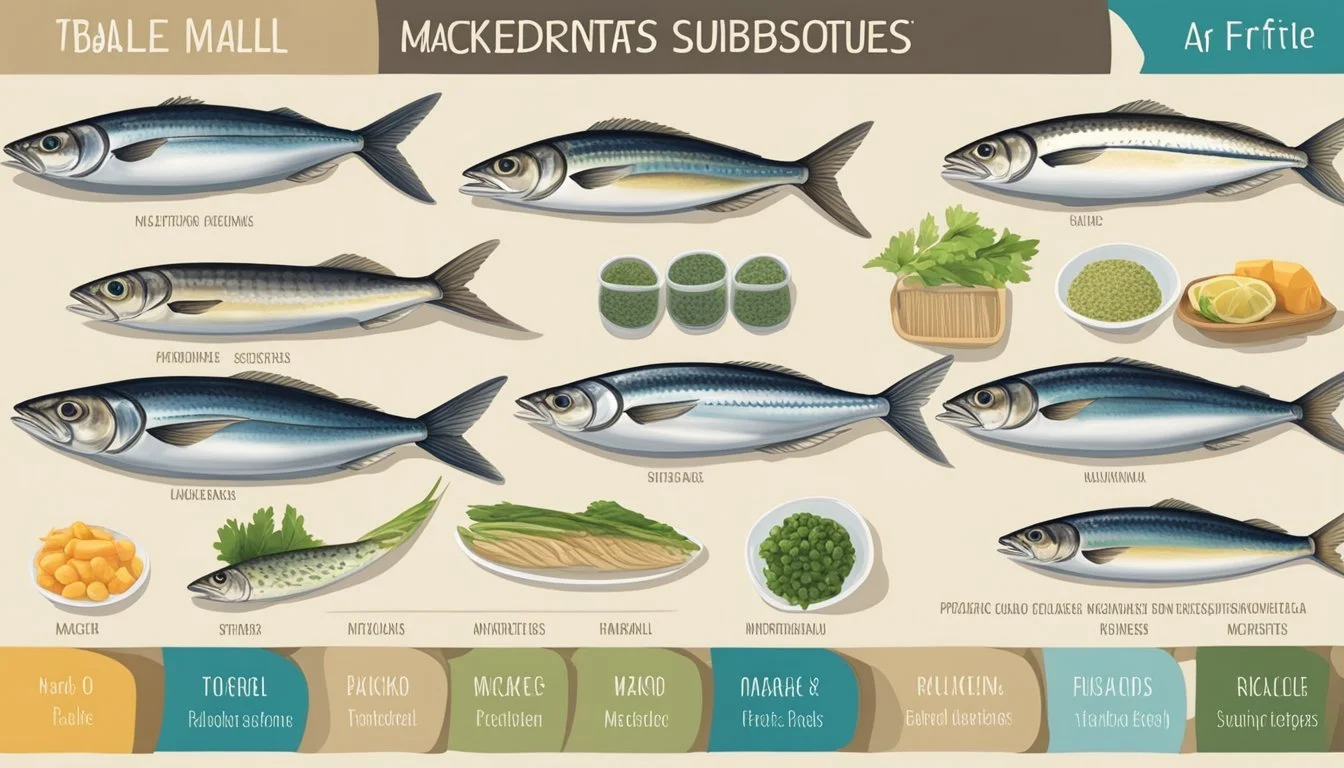Mackerel Substitutes
Top Alternatives for Chefs and Home Cooks
Finding the perfect mackerel substitute can be a challenge for seafood enthusiasts looking to replicate its unique flavor and nutritional benefits. American shad, with its salty, sardine-like taste and high oil content, offers a viable alternative, especially when smoked, fried, or poached. Salmon is another excellent option, sharing similarities in taste and richness in omega-3 fatty acids, which are essential for maintaining heart health and brain function.
Grilling enthusiasts might consider other oily fish like bluefish or mahi mahi, known for their robust flavors and firm textures. With proper seasoning and cooking techniques, these fish can provide an experience similar to mackerel. Choosing sustainable fish options is also crucial to ensure that substitutes don't negatively impact the environment, making ocean trout or steelhead trout wise choices.
Different cooking methods can highlight the strengths of various substitutes. Baking or pan-frying alternatives like sea trout and striped bass can achieve textures reminiscent of mackerel. By selecting the right substitute, home cooks can maintain the desired flavor profile and nutritional value while considering sustainability factors.
Understanding Mackerel
Mackerel is a flavorful and nutrient-rich fish known for its oily texture and high omega-3 fatty acid content. Its characteristics, health benefits, and culinary uses make it a popular choice in various diets.
Characteristics of Mackerel
Mackerel is a small to medium-sized, fast-swimming fish found in both temperate and tropical seas. It has a distinctive shiny, oily skin with dark vertical stripes. Atlantic mackerel and King mackerel are common types, each with unique features. Atlantic mackerel has two dorsal fins with spines, while King mackerel's first dorsal fin contains spines, and the second has soft rays.
This fish is highly valued for its rich, strong flavor and high oil content, making it ideal for various cooking methods. Mackerel is also known for its flaky, tender texture when cooked properly.
Health Benefits of Mackerel
Mackerel is a powerhouse of nutrients. It is rich in omega-3 fatty acids, which are crucial for heart health and brain function. These fats help reduce inflammation, lower blood pressure, and decrease the risk of chronic diseases.
Additionally, mackerel is an excellent source of protein, essential for muscle growth and repair. The fish is packed with vitamins such as Vitamin D and B12, and minerals like selenium, which support the immune system and thyroid function. However, it is important to be mindful of mackerel’s mercury levels; consuming in moderation is recommended.
Culinary Uses of Mackerel
Mackerel is versatile in the kitchen, capable of being baked, grilled, smoked, or poached. Its high oil content allows it to withstand various cooking methods without drying out. Seasoning with herbs and spices enhances its robust flavor.
For baking, mackerel should be cooked at 350-400°F until it flakes easily with a fork. It is often grilled or fried for a crispy exterior and tender interior. Smoked mackerel is popular for its deep, savory profile. Incorporating mackerel into salads, pastas, or sandwiches can also add a nutritious boost to meals.
Conclusion
By understanding the specific characteristics, health benefits, and culinary diversity of mackerel, one can truly appreciate the value this fish brings to a well-rounded diet.
Factors in Choosing a Substitute
Choosing a substitute for mackerel involves weighing factors such as taste, texture, nutritional content, and availability.
Taste Profile Comparison
When selecting a substitute for mackerel, taste is a primary consideration. Mackerel has a strong, rich, and somewhat salty flavor. Alternatives like salmon and American shad offer similar profiles.
Salmon: Rich flavor, slightly less salty, with a mild sweetness.
American Shad: Salty and sardine-like, making it a fitting replacement in many recipes.
Balancing these flavors ensures that the substitute complements the dish effectively.
Texture Considerations
Another important factor is the texture of the fish. Mackerel is known for its firm, flaky, and oily texture. The texture significantly impacts how the fish behaves in different cooking methods.
Salmon: Firm and flaky, with a similar oily texture.
American Shad: Also firm but can contain more bones, affecting the dish's preparation.
Matching the texture helps maintain the desired mouthfeel and structure in a recipe.
Health and Nutrient Comparability
Nutritional content is crucial, especially regarding protein and omega-3 fatty acids. Mackerel is renowned for its high omega-3 content, beneficial for heart health and brain function.
Salmon: High in protein and omega-3 fatty acids, offering comparable health benefits.
American Shad: Contains good levels of omega-3s though it may vary.
Ensuring that the substitute offers similar nutritional value supports a balanced diet.
Availability and Seasonality
Availability can vary significantly between different types of fish. Mackerel is often seasonal, so finding a reliable substitute means considering the time of year and sustainability.
Salmon: Widely available year-round, both fresh and frozen.
American Shad: More seasonal and may be harder to find depending on the region.
Considering availability and sustainability ensures that the choice of substitute aligns with ethical and logistical considerations in cooking.
Substitutes for Mackerel
When looking for substitutes for mackerel, it's essential to consider factors such as flavor, texture, nutritional value, and sustainability. Some alternatives include similar oily fish, mild-flavored options, special diet-friendly choices, and eco-friendly sustainable fish.
Similar Oily Fish
Salmon stands out as an attractive mackerel substitute due to its high levels of omega-3 fatty acids. Its firm, flaky texture and rich, oily flavor make it a versatile replacement in various dishes. Tuna is another excellent option, especially for those who enjoy strong, robust flavors. American Shad and Sardine also offer a good oily texture and can work well smoked, fried, or poached.
Mild Flavored Alternatives
For those who prefer a milder taste, Trout and Halibut are suitable choices. Trout has a delicate flavor and tender flesh, making it easier on the palate while still providing essential nutrients. Butterfish is another mild option with a creamy texture and is ideal for those who want a gentler substitute. Bluefish also provides a medium flavor that can work in various recipes where mackerel might be too strong.
Substitutes for Special Diets
When catering to special dietary needs, several fish options can fit the bill. Swordfish is a robust substitute that offers a substantial texture and is typically safe for many dietary restrictions. For those seeking a leaner alternative, King Mackerel provides essential nutrients without the intense oiliness. For individuals with specific dietary concerns, it's essential to choose substitutes with similar nutritional profiles and allergenic properties.
Eco-Friendly Sustainable Options
Sustainability is a crucial factor when selecting fish substitutes. Spanish Mackerel is recognized for being a more sustainable choice compared to other mackerel varieties. Halibut and Salmon certified by the Marine Stewardship Council can be excellent environmentally conscious alternatives. Seafood Watch recommends several eco-friendly choices, including Sardine and Trout, which are often caught using methods that have a lower impact on marine ecosystems.
Utilizing sustainable options helps protect ocean health while providing nutritious and delicious alternatives to mackerel.
Cooking Techniques for Substitutes
Preparing mackerel substitutes effectively requires using specific cooking techniques that enhance their natural flavors and textures. Below are some practical methods to cook mackerel substitutes, focusing on grilling, smoking, baking, roasting, frying, sautéing, marinating, and seasoning.
Grilling and Smoking
Grilling and smoking are excellent techniques for bringing out the rich, oily textures of substitutes like salmon and American shad.
By grilling, a slight char is added, creating a delectable contrast against the fish's buttery texture. When smoking, it’s essential to maintain a low and steady heat to prevent drying out the fish. Smoke with hardwoods like oak or hickory to introduce deep, aromatic flavors. Use a marinade or rub with ingredients such as garlic, lemon, and fresh herbs to complement the fish.
Baking and Roasting
Baking and roasting are versatile methods suitable for various fish substitutes, including salmon and bluefish.
Set the oven to 350°F (175°C) and prepare the fish with a light coating of olive oil and seasoning. To maintain moisture, especially for flaky types, cover them lightly with foil or parchment paper. Combining baking with fresh herbs, lemon slices, and mild spices can enhance the flavor profile. Roasting at high temperatures can brown and crisp the fish's exterior while keeping the inside tender.
Frying and Sautéing
Frying and sautéing are effective for achieving a crispy exterior and savory flavor, particularly with substitutes like salmon and mackerel.
Using a non-stick pan, heat some olive oil or butter until it shimmers. For frying, coat the fillets lightly in flour or breadcrumbs if a crunchier texture is desired. Season with salt, pepper, and other herbs like dill or parsley. Cook over medium-high heat for about 3-5 minutes per side, making sure the fish flakes easily with a fork.
Marinating and Seasoning
Marinating and seasoning are crucial steps to infuse fish substitutes with deep flavors.
Create a marinade using ingredients like soy sauce, ginger, garlic, and citrus juices. Allow the fish to soak for at least 30 minutes before cooking to help the flavors penetrate. Fresh herbs, such as thyme and rosemary, work well with oily textures. Balanced seasoning can also be achieved with salt, pepper, and specific flavor pairings like capers, tomatoes, or olives to enhance the substitute's natural taste.
Nutritional Information of Substitutes
When choosing a substitute for mackerel, it is essential to consider the nutritional value of the alternatives. Here is a comparison of some common mackerel substitutes:
Salmon is a popular substitute due to its high omega-3 fatty acids content, beneficial for heart and brain health. It is also rich in protein and B Vitamins (B6 and B12).
American Shad
American shad has a similar nutrient profile to mackerel, featuring high levels of omega-3 fatty acids and protein. However, it contains numerous bones, which can be challenging when preparing.
Rainbow Trout
Rainbow trout is another excellent alternative. It provides significant amounts of Vitamin D, omega-3 fatty acids, and selenium, supporting bone health and immune function.
Sardines
Sardines are rich in calcium, iron, and omega-3 fatty acids. They also provide high levels of Vitamin D and protein, beneficial for maintaining bone and heart health.
Table of Nutritional Content (per 100g):
Nutrient Mackerel Salmon American Shad Rainbow Trout Sardines Omega-3 (g) 5-8 1.5-2.5 1.7-2.4 0.9-1.5 1.4-2 Protein (g) 18-20 20-25 18-21 20-22 21-23 Vitamin D (IU) 360-500 250-600 200-400 500-600 250-300 Calcium (mg) 12-20 10-15 8-12 15-18 360-400 Iron (mg) 1.6-2 0.8-1.2 1.9-2.5 0.5-1 2.9-4.8 Selenium (mcg) 43-48 36-46 34-39 12-14 45-50
These substitutes offer diverse nutritional benefits that can meet various dietary needs.
Purchasing and Storage Tips
When selecting mackerel substitutes, prioritize freshness and quality. Visit a trusted fishmonger who can provide information on the catch's origin and ensure the seafood meets high standards.
Consider sustainable seafood options to support environmental responsibility. Look for eco-certifications like the Marine Stewardship Council (MSC) label.
Freshness is crucial. The fish should have bright, clear eyes and firm, shiny flesh. Avoid fish with a strong, unpleasant odor. If the choice is limited, frozen fish can be an acceptable alternative.
For storage, keep the fish at cold temperatures immediately after purchase. Refrigerate at or below 39°F (4°C). Use clean, airtight containers made of glass or plastic to maintain quality and prevent cross-contamination.
Freezing is another option for longer storage. Wrap the fish securely in plastic wrap, followed by aluminum foil, or use vacuum-sealed bags. This minimizes freezer burn and keeps the fish in good condition for several months.
For those conscious of sustainability, check the species' status and choose options that help preserve marine ecosystems. This approach supports conscious consumer habits and ensures the longevity of fish populations.
In summary, focusing on freshness, quality, and sustainability when purchasing and storing mackerel substitutes results in better flavor, nutrition, and environmental impact.
Serving Suggestions and Pairings
When substituting mackerel, consider the meaty texture and delicate taste of your chosen fish.
Flavor Pairings
Pairings like lemon, olive oil, pepper, and garlic complement the natural flavors. Mustard and parsley enhance the profile, while white wine and citrus add brightness.
Side Dishes
For a balanced meal, serve with:
Steamed broccoli: Offers essential nutrients and a fresh taste.
Mixed green salads: Light and refreshing, they balance the richness of the fish.
Pickled vegetables: The acidity cuts through the oiliness.
Cooking Methods
Regardless of the fish you choose, cooking methods such as baking, frying, or grilling maintain the fish's nutritional value:
Baking: Preheat to 350°F (175°C). Bake for 10 minutes per inch of thickness.
Frying: Use a non-stick pan with a small amount of olive oil. Fry for 3-5 minutes per side.
Sample Menu
Course Dish Main Grilled salmon with lemon and garlic Side Steamed broccoli with olive oil drizzle Vegetable Pickled carrots and radishes Beverage Glass of chilled white wine
Additional Notes
White wine complements the meaty texture and delicate taste of fish substitutes. Fresh herbs like parsley and citrus infusions enhance flavor, making your meal both delicious and nutritious.
Always season to taste and adjust pairings to fit personal preferences.








